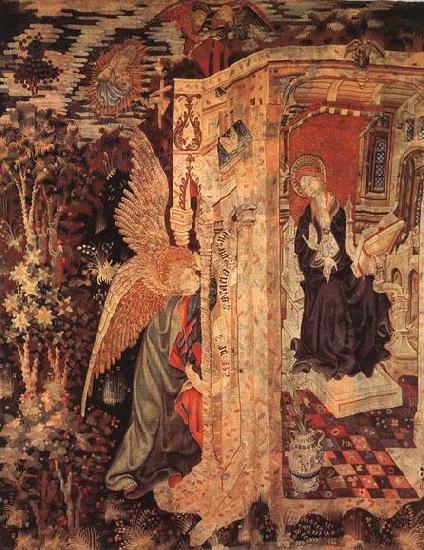New Crafts LLC
Las Reproducciones del Oleo de Europa España Dirigen
Pintura Identificación:: 64183
unknow artist
The Annunciation
1410s Woollen tapestry, 345 X 290 cm The Cloisters Collection, Metropolitan Museum of Art, New York Tapestries provided a very suitable medium for the stylistic expression of the International Gothic art. While, in general, tapestry weaving attempted to solve the same problems as those raised by painting, the opposite can be observed in the period about 1400: it was then in fact painters who endeavoured to achieve effects like tapestry by the homogeneous texture of their pictures, which were made up from tiny, dense and decoratively stylized repeated elements. It is a characteristic feature of the International Gothic style to endeavour to make the various motifs appear to be of the same quality, and to give them the fluid lines of textiles. These endeavours felicitously made use of the possibilities offered by tapestry-weaving. In general terms the composition follows that of Broederlam's Annunciation; it is from the open air that the angel approaches the Virgin, who is enthroned in a chapel-like building. The upper outlines of the chapel are set off by the contrast of the brown mountain which looms up behind the building. On the left luxuriant vegetation stretches up towards the sky, where a half length figure of God the Father appears surrounded by a golden mandorla. Narrow bands of white cloud form a rhythmically repeated pattern on the sky around him. The building looks as if it were made of some rigid fabric, for its column is like a thick cluster of cables, decorated with recurrent multicoloured motifs. The bottom edge is a fluctuating line, as if the ground were creeping up the wall. This may be a stylized version of the hillside to be seen beside Broederlam's pavilion. As though to counter-balance the luxuriant vegetation on the left side, the floor of the chapel is covered with a mosaic of amazing variety. There are no duplicates among the geometrical forms, which alternate with stylized foliate motifs. The natural surroundings are also luxuriantly decorative: plants of different kinds will spring from the same stock. However, it is not only with the abundance of forms of trees, leaves and flowers that the forest astonishes us, but with its sense of magic and mystery. The trunks of the trees with their vibrant lines, the flowers, which resemble stars, and the clusters of leaves are illuminated by shimmering lights. The same vegetation that is resplendent in bright colours in front of the building and on the left side of the tapestry, darkens behind the angel on the right creating, as if by magic, a mysterious, nocturnal darkness around the heavenly messenger, a darkness out of which only a few stylized foliate forms shine forth. The rigid stems apparontly have no connection with the petals (for example between the wings and the back of the angel). This vegetation has marked affinities with the foliate forms in the so-called Paris Apocalypse, a work also produced in the Low Countries, where the same motifs again produce a most expressive effect. , Artist: UNKNOWN MASTER, Flemish , The Annunciation , 1401-1450 , Flemish , painting , religious

Vea nuestra galería en Suecia







